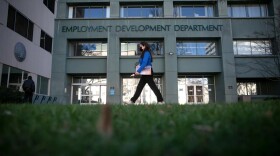Top story immigration policy in the proximity of the Mexican border create their own set of problems for San Diego. Two of those problems are homelessness and addiction whether it's former American residents deported who end up on the streets in Tijuana or Mexicans living in San Diego a legally shelters scarce. And the people who try to provide for them. They are very vulnerable to drug addiction. Tomorrow followed Joe's village in the University of San Diego will host what they call a good neighbor dialogue And joining me today on midday to explore the issue are as need, and Ruth Perlin Avenue is director of the University of San Diego transborder Institute and thank you for coming in. And Ruth is executive director of father chose same Vincent de Paul Village think you. When you combine the homeless population of San Diego will and Tijuana, what can we say about that award these folks. They are pretty different. I'll let Ruth talk about the same deal population since she's part of the major service population. Part of it is a classic population in poverty. People who have been excluded or dispossessed in various ways and very familiar with us in US but there's a significant portion of the population that our people are deported from the United States. Many times people web click here for five or 10 years and people who have successful lives here in the United States and let mortgages and jobs and Tijuana are major sources or major sites for deportation and 80% of people deported from the United States are deported along the Mexican border and the upper region. Deportation itself the US immigration policy is a major driver of homelessness in Tijuana So in Tijuana, not because they want to be there. Necessarily, but because that's where they have been left by immigration officials That's exactly right. They may come from different areas, but this is where US immigration officials leave them and use a wide do they say in Tijuana because they don't have the resources to get back to their home community, but most cases, because if family need that states and have the aspiration the other. The family will be able to visit the more easily along the border, or at some point they'll have to go back to United States. In Tijuana are most of the homeless people, men It's the majority I would say that though demographic has been changing and is starting to reflect the general Chandon deportation that there are more women and more children and diverse it Route not too long ago San Diego goes homeless was third in the nation, behind only New York and Los Angeles how law NDO ghost estimated home population? Now we ranked fifth not because of the amount of homeless people has decreased, but because other communities have had an increase in their homeless population, so it supersedes San Diego., Right now we have a little over 8700 people were homeless and about 4000 of them are on the street at any given time One stereotype. Perhaps of the homeless population in San Diego. It's more than the stereotype is that a lot of them are mentally ill. And drug addicted is that correct? They can certainly seem that way the people who have the substance abuse issue are the mental illness or the one to be a very might draw the visual tension and can be really the hardest to respond to them when you're just a person trying to go about your day on the streets. Proportionately estimates range 40 to 6% of the population as substitute to abuse issues and of that percentage a lot of them are going to have corresponding mental illnesses Getting back to you and you want to talk about US drug policy you talked about immigration policy and how that contributes to the problem. What about drug policy 's drug policy in both countries. There's just coincidence. On the one hand, you've got homeless people in the United States since we had been the Great Depression in Mexico we don't have a good account because a lot of people are in the informal economy. But then we also have in both countries dramatic uptake and drug addiction and substance abuse in the United States. If you look at format, LA Times is a terrific book we have a proven heroin addiction and it's really scary for the first time in a generation. There are more accidental deaths in from car accidents. Mexico is a have in a similar situation the last five years they had very little domestic market for drugs, it was mostly for sale in the United States has had a booming domestic market and huge new problem with addiction, so the if you overlap those two things. We know that Mexico is a producer and US is consumer now. Mexico is consuming a lot of the policies in Mexico to go after drugs haven't changed just spite the fact that the phenomenon has changed Doing know why the drug addiction has been come such a problem in Mexico There are many drivers to that economic changes. Some of it is desperation that comes with a 10 year drug war, it seems like it's never been, and 100,000 people that died and many hundred thousand displaced it's almost too. Drug edition is part of homelessness and it's the same here in San Diego. It's also a consequence of homelessness. When you have people that are deported or people from around the economy in their village or hometown has just been wiped out by global economic policies are changes in the have to move somewhere else and living in much more stable like with her family has been broken up by violence by the dynamics of immigration this is when people turn to drugs. Avenue, can you tell us that the homeless that were removed from the Tijuana River Canal because that was a real gathering point for homeless we heard that a lot of them were sent to drug rehab although we are not sure if that's correct Tijuana had a major initiative in L Bordeaux, which is the transcript and now last spring. So after heavy rains. There was a security concern about people living there on the two order of 2000 people were moved that it can output 1000 of those people were more or less picked up and moved somewhere else in Tijuana. What about half of them were supposedly put him read drug rehabilitation center which point joint condition nation and the Mexican federal government. They have jurisdiction over this canal. What we found over time, though, is that first of all, not all those people were put in rehabilitation work. Necessarily, drug addicts, secondly, we found, for example, for heroin addicts. There's no methadone which is a real problem forcing people to go cold turkey that are very little psychiatric all services in most of the facilities not all, there are couple that exception to this and most of the people basically been forced again facilities that are locked at night people are forced to work or volunteer during the day so policy that when it was announced by the Tijuana mayor look like something that was very progressive look, these are homeless brothers and sisters mentored of them. The drug assistance actually seems to have been what we're really doing clearing out Bordeaux and the sign of homelessness and forcing people into facilities that don't really have these resources or expertise do it that another words, it looks like something that happens with homelessness everywhere. The real politics we are taking something that is very visible and make it less visible but not dealing with the root of the problem Bureau are listening to midday edition. Avenue is director of the University of San Diego transborder Institute with Berlin is executive director of father Joe's villages same visit de Paul Village and the good neighbor form takes place at the Joan Kroc Institute for peace and Justice Peter University City 02 market-leading at 6 PM I know if you are gonna be there. I will be there with this video, please hot team, which is a team that deals with homelessness folks from father Joe village will be there, the director of the better organization that deals with homelessness in Tijuana and the people from USD that specialize in how ordinary people and students can get involved in the issue of homelessness as well Reflects talk about addressing the problem. One popular approach that people talk about a lot in this country is housing first. What does that mean? It is really effective for certain parts of the population and it's a resource that we haven't had readily available for many years and now it is available very smart move. And allows us to much more quickly placed someone in to their own apartment and either provide them short-term support if there issues are less intense or extreme. Or longer-term support where their rent is paid really in fertility, with a portion of their income , But does housing first mean that's the focus? Just get themselves sheltered don't pick to concerned off the bat that drug addition, mental health? No. That could happen, of course, but landlord would not be very happy with that. So we really have to have some supports in place for people where there are some minor issues for short-term because it won't take much time to clear that up or for those major issues such as substance abuse or mental illness. Some longer standing at supports that allow them to maintain that apartment we don't want them to return to the streets Sandy O go in Tijuana were different cities with different systems in Tijuana, how is homeless tell with if it is still with It's complex. There's a set of really great organizations organizations around one from the Salvation Army and familiar to us. They run shelters and soup kitchens and rehabilitation centers and these aren't Nonprofit groups, not government Yes, some public funding, but the big question in Tijuana has been who is responsible for these folks? Because a lot while the Mexican water agency had jurisdiction over them. And yet the Tijuana police periodically rated the camps there and the municipal government has had a real push and pull relationship with the homeless and their advocates, it's unclear I can't tell you that there's just one policy that deals with it. It is familiar and other thing I would notice there are some small projects that seem to be giving us some hope in a different approach. For example, there's a group called Puerto Farms for urban farming for homelessness. It is great organization. We started by a young venture capitalist and has volunteers on both sides of the border. I think K bps as reported on this little bit. So there are some small projects, but what we want is comprehensive plan that is not just for getting the homeless out of sight out of mind, but actually dealing with the underlining issues. It's a ruthless population people who used to live either in the United States, or in southern Mexico And that makes it difficult it is not a problem. You asked the global officials we do not create this enabling the federal government, but the reality is as a region that the binational region. Somebody has to take responsibility for Ruth is there a way that the agencies on the side of the border can work with folks on Mexico and make a difference? Yes we have done that it is not always easy. There are lots of laws that are for the good and then there are laws that make it more difficult and so we really have to work together in order to make an impact. It is not always easy, but yet keep trying I think one of you has used the word treatable whether homelessness is treatable. Avenue is it? Ruth is really more of expertise in Mayan., At least if we look at a range of policy options. This sort of law enforcement only or punitive only policies worry just trying to lock people up or just forcibly moved them from one place to another. If you contrast that with something that's based on the whole person, based on some kind of treatment homelessness is treatable how it's treatable the nuances of that which kind of programs which kind of prevention that's always an open question, and there always can't get it And Ruth this good neighbor form is something that happened last year and it's happening this year. What is the point of the form? It initiates a hallmark of good day, Vermont, where we are really trying to encourage people to look at their data a interactions, not just with the homeless population, but the community at large as their neighbors and that we can be good neighbors with one another for us, of course. It starts with the homeless population, but we have thousands of volunteers that help us to do that better and so neighbors helping neighbors is that momentum to bring about change treatable is always possible The good neighbor form takes place at the Joan B Kroc it peace and Justice Peter at the University San Diego tomorrow at 6 PM. My guess have been. Meat and Ruth Breland, she is executive director father Joe village same visit the Paul village thank you for coming in. And if meat is director of the University San Diego transborder Institute thank you have
A forum this week explores a growing homeless problem on the border, shared by San Diego and Tijuana.
Experts on Thursday will take a look at how the swelling homeless numbers in both cities are related at a forum hosted by Father Joe's Villages. They'll also look at what can be done to get people off the streets and into treatment and housing.
Ev Meade, director of the Trans-Border Institute, said the homeless population in both cities have their differences.
Meade said a lot of the homeless population are those who have been deported from the United States.
"Tijuana and Mexicali are major sites of deportation," Meade told KPBS Midday Edition on Wednesday. "Deportation, itself, is a major driver of homelessness. This is where immigration officials leave them. Sometimes they don't have the resources to get back to their home community or they have family in the United States."
The forum is a part of Good Neighbor Month, a campaign to raise awareness about homelessness and encourage San Diegans to be good neighbors to everyone, no matter where they live.
The forum runs from 6 p.m. to 8 p.m., at the Joan B. Kroc Institute of Peace and Justice Theater at the University of San Diego. The address is 5998 Alcala Park in San Diego.









